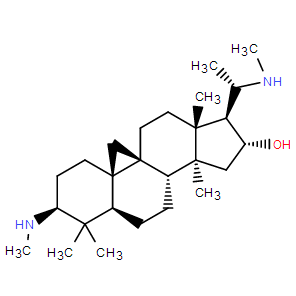| Cas No.: | 860-79-7 |
| SMILES: | C[C@@H]([C@H]1[C@@H](CC2([C@@]1(CCC34[C@H]2CC[C@@H]5[C@]3(C4)CC[C@@H](C5(C)C)NC)C)C)O)NC |
| Formula: | C26H46N2O |
| M.Wt: | 402.66 |
| Sotrage: | 2 years -20°C Powder, 2 weeks 4°C in DMSO, 6 months -80°C in DMSO |
| Description: | Cyclovirobuxine D (CVB-D) is the main active component of the traditional Chinese medicine Buxus microphylla. Cyclovirobuxine D induces autophagy and attenuates the phosphorylation of Akt and mTOR[1]. Cyclovirobuxine D inhibits cell proliferation of gastric cancer cells through suppression of cell cycle progression and inducement of mitochondria-mediated apoptosis[2]. Cyclovirobuxine D is beneficial for heart failure induced by myocardial infarction[3]. |
| In Vitro: | Cyclovirobuxine D (0-240 µM ;24-72 hours) shows a concentration- and time-dependent reduced cell viability after CVB-D treatment, only 10% MGC-803 cells and 20% MKN28 cells are alive at 72 h after treatment with 240 µM[2]. Cyclovirobuxine D (0-120 µM; 48 hours) arrests the cell cycle of gastric cancer cells at S phase in a concentration-dependent manner[2]. Cyclovirobuxine D (0-120 µM; 48 hours) leads to apoptosis in gastric cancer cells in a concentration-dependent manner, especially early stage apoptosis.Cyclovirobuxine D (0-120 µM; 48 hours) causes apoptosis via up-regulation of the apoptosis- related proteins, cleaved Caspase-3 and ratio of Bax/Bcl-2, in gastric cancer cells[2]. Cell Viability Assay[2] Cell Line: MGC-803 and MKN28 cells Concentration: 0, 30, 60, 120 and 240 µM Incubation Time: 24, 48, 72 hours Result: Reduced Cell Viability and Colony Formation Ability of Gastric Cancer Cells Cell Cycle Analysis[2] Cell Line: MGC-803 and MKN28 cells Concentration: 0, 30, 60, and 120 µM Incubation Time: 48 hours Result: Arrested cell cycle progressions of MGC-803 and MKN28 cells. Apoptosis Analysis[2] Cell Line: MGC-803 and MKN28 cells Concentration: 0, 30, 60, and 120 µM Incubation Time: 48 hours Result: Induced apoptosis of MGC-803 and MKN28 cells. Western Blot Analysis[2] Cell Line: MGC-803 and MKN28 cells Concentration: 0, 30, 60, and 120 µM Incubation Time: 48 hours Result: Up-regulated cleaved Caspase-3 and Bax and decreased the expression of Bcl-2 expression. |

 DC Chemicals' products qualify for U.S. tariff exemptions. We guarantee no price increases due to customs duties and maintain stable supply, continuing to deliver reliable research solutions to our American clients.
DC Chemicals' products qualify for U.S. tariff exemptions. We guarantee no price increases due to customs duties and maintain stable supply, continuing to deliver reliable research solutions to our American clients.





















